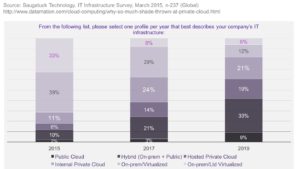Snapshot of Cloud Computing for Enterprise IT
There is a loudly expressed opinion that ‘the cloud’ is the future of computing and that companies such as Amazon, Google, and Microsoft will dominate the market, replacing established hardware and software vendors such as IBM, Dell, HPE, and Oracle. In some ways, this is true especially for startups, small companies, and perhaps even some midsize companies, but the situation for enterprise level deployments is very different.
For small companies, the use of cloud services minimizes the need for capital expenditure on infrastructure and the recruitment of IT specialists, accelerating their time to production, possibly at the expense of some customization.
By contrast, enterprise level organizations typically have a substantial reliance on established business critical applications. Many of these applications cannot easily be rewritten or re-deployed on public cloud architectures. Sometimes the systems they run on are not based on the x86 architecture, further complicating matters.
Existing enterprise applications, however, can and often need to be integrated with new cloud services to deliver a modern infrastructure as a cloud service while ensuring business continuity. This hybrid approach is an optimum combination of private and public cloud services. It leverages existing data center and infrastructure resources and combines elastic cloud services from external providers when needed. For businesses where regulation and compliance may affect where and how data may be located and accessed, or if large memory scale up data systems may be UNIX-based and are not well-suited or compatible with scale out Intel-based architectures, a hybrid cloud is particularly advantageous.
A Business Solution to the Cloud Problem
Enterprise customers are much more concerned with a business solution to their cloud problem than just a technical solution. Minimizing costly changes is valuable to them as long as the underlying technology has a reasonable and real roadmap. For them, a mixture of private and public cloud can address multiple requirements:
- Application availability, without a big cost to port, migrate, and re-deploy
- Governance, where ownership, location, and management of resources can be customized for different parts of a distributed cloud application
- Modernization, driven by new technologies that enable new capabilities but remain “under the hood”
This approach focuses on business optimization, integrates and consolidates disparate systems, offers a flexible choice of on-premises, managed on-premises, or off-premises cloud.
For enterprise customers, this is a critical transformation. The service provider model is generally accepted as the way forward, but successfully navigating the journey requires the integration of existing business critical systems with new and agile applications. This requires differentiation at a business service level, it is not technology driven but must incorporate both the old and the new while optimizing capital costs and operational margins.
Market Landscape
Cloud computing means fewer but larger buyers of infrastructure technologies. Cloud service providers such as Amazon and Google buy standardized systems in large volumes. Other CPU and infrastructure vendors have doubled down on the capabilities of their architectures to support both legacy and modern systems.
Among established technologies, x86 continues to dominate at the CPU level but is unable to reach a large body of enterprise applications that were written for IBM, HP, and Oracle/Sun. HP has effectively moved to x86 and is not offering its own public cloud service. IBM has formed the OpenPower consortium as it attempts to build an ecosystem and is building its Softlayer cloud service, but relies on application software partners to complete the stack. This leaves Oracle in the unique position of offering chips-to-apps-to-cloud in one place supporting x86 as well as its own SPARC chip (with the SPARC Dedicated Compute Service). As the only UNIX public cloud service available from a major systems or cloud vendor, Oracle has a robust roadmap with everything available on-premises, managed-on-premises, and off-premises.
Comparing ‘Market Hype’ to Reality
For most enterprises, a successful transition to cloud service-based infrastructures is more important than a rapid transition. There are many market research reports that discuss the nature and pace of cloud adoption in ‘the Enterprise’, but one thing they have in common is the limited pace and scope of public cloud adoption. At the end of the day, it is business and workload considerations that drive decisions, not technology.

While the graph (same link as the image) is slightly dated (2015), the trends have not changed and the presented results are still indicative. The common trends demonstrate that dependence upon isolated on-premises systems – even if virtualized – is declining. Private cloud, whether on-premises or hosted is and will be a substantial part of the market, but the dominant and growing sector that seems destined to dominate is hybrid cloud, a combination of on-premises, hosted and public cloud services.
For many enterprises, the challenge is to find a vendor that can offer all of those things with a viable business model. We live in very interesting times when the only global technology vendor that appears to be able to meet all the criteria is Oracle, with a viable alternative to Intel Architecture in the form of SPARC.
The OrionX editorial team manages the content on this website.






